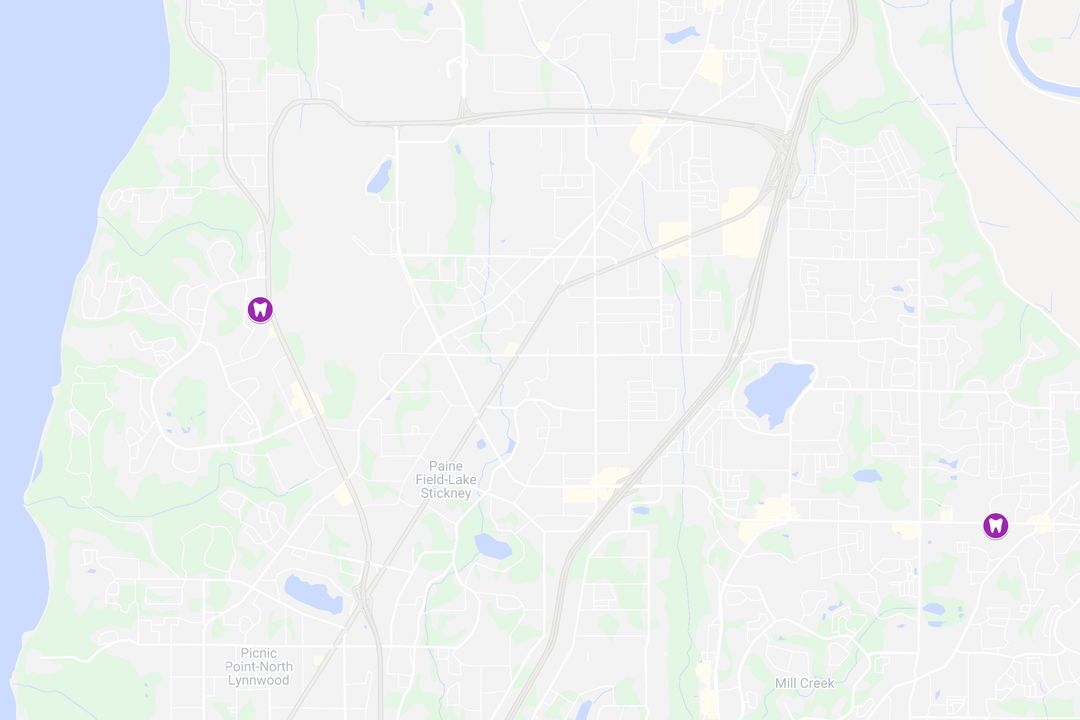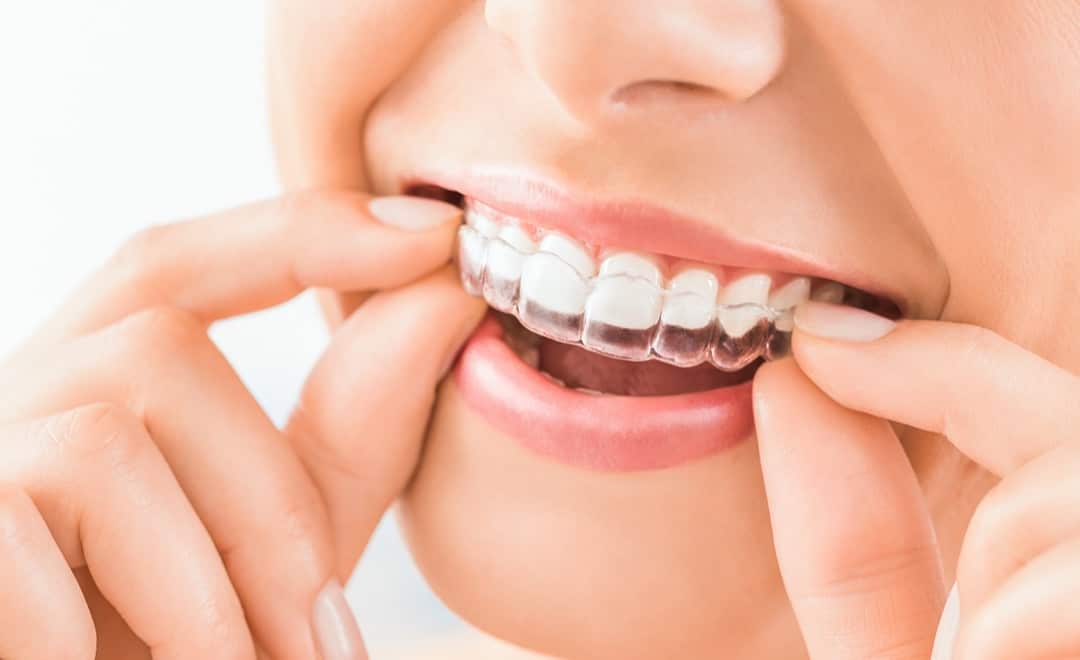FAQs
General FAQs
Will Braces Hurt?
Orthodontic treatment has come a long way in recent years. New technology allows us to use lighter forces to move teeth over a much shorter amount of time.
You can expect braces to make your teeth sore for a few days after they are placed and after each adjustment. These adjustments will make you more conscious of your teeth, but they should not be too painful. This discomfort can be relieved with an over-the-counter pain reliever such as ibuprofen or acetaminophen (use as directed).
Today’s braces are smaller, more comfortable, and use technology that reduces the sensitivity. We use the latest in orthodontic technology and the highest quality of orthodontic materials in order to reduce discomfort and treatment time.
How long does Orthodontic Treatment take?
The answer will vary because no two cases are alike.
Shorter cases in younger patients can take 6-9 months, most intermediate cases can take 9-15 months, and comprehensive treatment lasts from 18-24 months. We finish many cases in less than 18 months, however, certain cases may take significantly longer.
What is Full/Comprehensive Orthodontic Treatment?
This refers to orthodontic treatment when all permanent teeth are erupted (all of your adult teeth have come in and you no longer have any baby teeth). It is more commonly used when a Phase I treatment was not performed.
What are Phase 1 and Phase 2 treatments?
Two-phase treatment is not a clever way for orthodontists to get you into two sets of braces, we promise.
Two-phase treatment simply means that there will be two separate parts to your orthodontic treatment. Though slightly more funds and time are involved, we assure you that this does not double the cost and treatment time for you. Though we try to avoid this when possible, in many cases, it is needed for the best end result.
Phase I treatment is aimed at intercepting a moderate or severe orthodontic problem early in order to reduce the severity or eliminate it. These problems most often include crossbites (of the front or back teeth) and crowding. Phase I treatment takes advantage of the early growth spurt and turns a difficult orthodontic problem into a more manageable one. This can also greatly help self-confidence in a young child who is being teased or embarrassed by the position of his or her teeth. This phase of treatment usually begins while the permanent front teeth are erupting (typically around the age of 8-9). We usually recommend this treatment when waiting could cause orthodontic problems or social problems to worsen.
Phase II treatment will occur after all permanent teeth have completed eruption (no more baby teeth are present). This serves to complete proper alignment which cannot be achieved with baby teeth present. In our office, this phase of treatment is significantly discounted due to the expense of Phase I treatment.
Does everyone need Phase 1 treatment?
Absolutely not! Only certain orthodontic problems require early intervention. In fact, most of our patients are able to wait until most if not all of their permanent teeth erupt to begin their orthodontic treatment.
If Phase 1 treatment is recommended, can I wait until my child is older?
This is not recommended. If your child needs Phase I treatment, this usually means that they have a difficult problem that requires attention now. If no orthodontic action is taken, treatment options become limited, more difficult, and the long-term stability may be compromised. In addition, it may lead to extractions, jaw surgery and increased costs.
Can you be too old for braces?
NEVER! While adult teeth sometimes move a little slower than children’s teeth, you are never too old to benefit from braces.
A large portion of Dr. Chad Carver’s practice is devoted to adult orthodontic care. In fact, he has several patients in their 50s, 60s, and even 70s!
What are extraction and non-extraction treatments?
Extraction treatment means that permanent teeth need to be removed. The two most common reasons are to relieve severe crowding and to allow the front teeth to be pulled back if a patient’s teeth and profile are too protrusive.
Non-extraction treatment is accomplished by expanding the arches in order to make room for all of the permanent teeth. It is less common to have permanent teeth extracted with today’s orthodontic techniques, but still may be an option in your treatment. Our first choice is to not extract permanent teeth, but our greater purpose is to give you the best result possible.
We will carefully evaluate your case and recommend the decision that gives you the smile you deserve!
Can I still get braces if I have missing teeth?
Absolutely! When teeth are missing, the teeth on each side of the space will tend to drift into the empty space creating a number of problems.
These open spaces between the teeth are unattractive and can detract from your smile. Additionally, tipping of the teeth can lead to problems with function and recession of the gum tissue. Orthodontic treatment will correct and prevent these problems and will also provide proper alignment for your dentist to replace the missing teeth.
How do I know if my child needs braces?
Even if their front teeth are straight, there may still be underlying bite issues that need to be determined by an orthodontist.
Conversely, there are some problems that look intimidating and complex which will resolve on their own. Our initial exam is complimentary and we would be more than happy to offer our honest recommendations.
What age should my child be seen by an orthodontist?
What are the early symptoms of orthodontic problems?
- Do you feel embarrassed when smiling or laughing?
- Do you have trouble chewing or biting your cheek?
- Is it difficult to clean between your teeth or do you frequently get food caught between your teeth?
If you answered yes to any of these questions, then orthodontic treatment can help.
Airway Orthodontics FAQs
How is OSA Treated?
How can we help?
Emergency Care FAQs
What to do if something needs immediate attention?
What if I have a loose bracket or bands?
What if my wire is irritating or cutting my cheek?
What if I lose a separator?
What do I do about aches and discomfort with orthodontic treatment?
Financing FAQs
Will my dental insurance cover braces?
Many dental insurance plans cover the cost of orthodontics including Invisalign®, metal, or clear braces. Insurance coverage varies depending on your plan. In most cases, you can contact your insurance provider to learn about what is covered or not covered. If you are still uncertain, give us a call at 425-382-8000 and we can help you find out your coverage for orthodontia.
Is Invisalign® more expensive than braces?
No. Treatment with Invisalign® is almost always the same as the cost would be for comparable treatment with braces – and sometimes even less! In addition to Invisalign®, we offer other types of clear aligners that can be used for more limited tooth movement. These cost even less than Invisalign®.
Is there an additional charge for retainers?
No. Your treatment fee will include any retainers that are needed to hold your teeth in their new position. It will also include one additional set if needed. Afterwards, there is a small charge to repair or replace a broken or lost retainer.
Is there a family discount?
Yes. We know you will be so happy with your smile that you will want your immediate family members to have one too. For each additional immediate family member, we will provide a discount.
What financing options are available?
Some of our patients choose to pay in full for orthodontic treatment and can receive a large discount. However, most patients choose to finance their orthodontic treatment over the course of several months or even years. We will help customize a solution for your financial needs.
Will my Flexible Spending Account (FSA) cover my braces?
Yes. Orthodontic treatment almost always qualifies for FSA reimbursement. If your employer offers an FSA, let us know and we will verify your eligibility and help you get started.
Are there any other hidden costs or fees?
No. The price you pay for your orthodontic treatment covers everything we do to complete your treatment. It even covers your retainer adjustments for a year after your treatment is complete.
Invisalign® FAQs
How does Invisalign® work?
First, a 3D scan of your teeth will be done at your initial visit to Stellar Family Orthodontics. Dr. Chad Carver may take this 3D scan and digitally straighten your teeth to simulate what your smile will look like after the Invisalign® treatment. If you like what you see, we will then submit the 3D scan of your teeth to Invisalign® and we will work with them to plan how each tooth will move. Remember, digital teeth can be made to move anywhere, but our providers understand how real teeth biologically move within bone. They’ll work with Invisalign® to ensure that each movement is appropriate and practical so that you can attain the smile you want within the shortest amount of time.
A series of customized clear plastic aligners – typically between 30 to 40 – will then be manufactured by Invisalign® and fitted by our team. Each aligner is to be worn for about 10-14 days before being replaced with the next one in the series. Progressively, these aligners will move your teeth into perfect alignment. Every 10-12 weeks we will check to ensure the movement of your teeth matches the movements that have been digitally predicted for your teeth. If your teeth move as planned, we will give you the next set of aligners. If your teeth do not move as predicted, we will take another 3D scan of your teeth and have Invisalign® create a new set of aligners until we get your smile looking beautiful and your bite looking healthy.
What are the benefits of Invisalign®
1. Removable:
Trays can be removed so that it’s easy to eat, brush, and floss during treatment
2. Comfort:
They are much smaller, smoother, and more comfortable than traditional metal braces so patients experience less gum and cheek irritation
3. Gentle tooth movement:
Invisalign® exerts less force on teeth so patients experience less pain after each adjustment
4. Aesthetic:
Invisalign® braces are clear and almost totally invisible so most people will not even know you are wearing them (unless you tell them, of course!)
5. Effective:
While traditional braces work wonderfully to straighten teeth, Invisalign® technology is rapidly evolving and can effectively treat a large number of orthodontic problems. Approximately 70% of all orthodontic patients can be treated with Invisalign® instead of traditional braces. There are even some situations where Invisalign® is an even more effective option than traditional braces, such as open bite cases.
See actual patient’s Invisalign® stories.
6. Fewer office visits:
Invisalign® patients are seen approximately half as many times as patients undergoing traditional braces. In fact, the average Invisalign® patient is seen approximately 8-10 times in total versus 14-16 times for regular braces. This is really great for busy teens and working adults who find it difficult to take time off.
7. Shorter office visits and evening appointments:
Invisalign® appointments are approximately 25 minutes versus 45 minutes for traditional braces. As the appointments are shorter, it is easier to schedule these appointments in the evening during the school or work day.
8. No dietary restrictions:
Eat what you want when you want. Unlike traditional braces that cannot be removed, you can remove the Invisalign® trays when you eat and thus do not have to avoid certain trouble foods like popcorn, gum, nuts, apples, or even sticky candies!
9. Fewer emergency appointments:
Traditional braces have brackets that can break, wires that can poke, and elastics that can come off. Invisalign® is not permanently glued into your mouth and does not have any small, fragile components that can break off.
10. Digital smile simulation:
At Stellar Family Orthodontics, we can take a 3D scan of your teeth and provide you with a digital smile simulation of what your teeth will look like with Invisalign®.
11. Dedicated Invisalign® Center:
Stellar Family Orthodontics has dedicated Invisalign® treatment rooms where adults can get treatment in comfort and privacy.
What are the drawbacks of Invisalign®?
1. Successful Invisalign® treatment is dependent on wearing the trays for at least 22 hours a day. Simply put, if you don’t wear the trays, then Invisalign® won’t work. It’s not like traditional braces where the braces are glued onto your teeth and are at work 24 hours a day from the moment you get them on to the moment they are taken off. If you do not think that you will remember to wear the aligners, then Invisalign® may not be the right fit for you.
2. Not everyone is an Invisalign® candidate. Certain types of tooth movements which are easy in traditional braces can be complicated with Invisalign®. The opposite is also true – certain cases are treated more effectively and faster with Invisalign® compared to traditional braces. A consultation with our providers is the best way to find out if Invisalign® is right for you.
How do I get started with Invisalign®?
The first step in getting started with Invisalign® is to book a free orthodontic consultation. At this appointment, we will assess whether you are a good candidate for Invisalign®. We may take a 3D iTero scan of your teeth and show you a simulation of how your teeth will look after your completed Invisalign® treatment. At this appointment, we will also explain each step of the process to you and answer any questions you may have.
Are you curious about Invisalign®? We can guide you through the process from start to finish. Give us a call to schedule a FREE Invisalign® consultation. We look forward to meeting you!
Invisalign® First FAQs
What is Invisalign® First?
Invisalign® First aligners are:
- Designed to treat a broad range of teeth-straightening issues in growing children, from simple to complex, including crowding, spacing, and narrow dental arches.
- Removable for easy hygiene, making it easier for growing children to brush and floss.
- Designed for comfort – which means no discomfort from rubbing brackets or poking wires.
Why Invisalign® First?
Invisalign® First is used for making various corrections in the positioning of a growing jaw with unique features for dental arch expansion and creating room for incoming teeth.
Invisalign® First can be used to address various orthodontic conditions, such as:
- Arch development
- Expansion
- Spacing/crowding
- Aesthetic alignment and crossbite correction
- Overbite, tooth protrusions or interferences
How does Invisalign® First work?
Invisalign® First works by expanding and contouring your child’s jawline through what is known as dental arch expansion. Dental arch expansion involves pushing your child’s teeth over time to increase the width of their dental arch.
The procedure for dental arch expansion starts with a consultation to determine if your child is an appropriate candidate for Invisalign® First. If approved, we can begin taking pictures, x-rays, and impressions of your child’s smile that same day. Information from the imaging, x-rays, and impressions will go to an Invisalign® laboratory where custom Invisalign® First aligners (trays) will be made for your child.
It will take a few weeks until the custom aligners are created. Once the aligners are ready, your child will be scheduled to come back to Stellar Family Orthodontics so we can custom fit the aligners to their smile. Over time, the trays will improve your child’s tooth position and help the growth of their jaw.
Depending on your child’s needs, they may require a full pair of aligners or just one arch alignment. Certain teeth may require attachments to be placed on their surface. Attachments will help direct forces from the aligners to the necessary teeth.
What are the pros and cons of using Invisalign® First?
Invisalign® First provides various benefits to meet the needs of growing children.
Benefits of Invisalign® First include:
- Allowing younger children to receive a similar Invisalign® experience to adults and teens.
- Customized planning around your child’s unique dental needs.
- Treatment for a broad range of orthodontic issues.
- Providing room for incoming teeth without removing surrounding teeth.
- Supporting teeth and jawline formation with preferred aesthetics vs. traditional braces.
- Your child can remove the tray to maintain comfort while eating, drinking, brushing their teeth, or other activities.
Drawbacks include:
- You have to remember to wear your aligners. They will not work unless worn for a minimum of 22 hours per day.
- The clear trays can be lost which will increase treatment time.
- Excellent compliance is required.
Invisalign® Teen FAQs
How does Invisalign® Teen work?
Invisalign® Teen is a clear aligner system for teeth, made specifically for teenagers. It provides an almost invisible way of straightening teeth using clear, removable aligners that are custom-made specifically for your teen’s teeth. Traditional braces use wires, brackets, and bands, while Invisalign® replaces all of these appliances with simple, clear aligners. Invisalign® looks similar to the plastic retainers that most teenagers get when they are done with their metal braces treatment.
How can these plastic trays actually move your teen’s teeth? They do it in a very similar way to how braces move your teeth. The aligners put pressure or tension on ligaments surrounding your teeth, gradually shifting them into a better position. Every two weeks, your teen will trade out the old aligner for a new one, and their teeth will continue to move. There may be some discomfort as the teeth adjust to the new aligner, but there is generally less discomfort than with metal braces.
Is Invisalign® more expensive than other types of treatments?
In most cases, the costs are about the same. We have found that one of the reasons many parents decide on metal braces instead of Invisalign® is the misconception that Invisalign® is more expensive than other treatments. If your insurance covers Invisalign®, you'll find that traditional braces and Invisalign® treatments cost relatively the same.
What happens if my teen loses an aligner?
In general, you can simply get a replacement by contacting us and letting us know that the aligners have gone missing. Depending on how close your teen was to swapping out those aligners for the next set, we might just move on to the next set and not worry about a replacement.
How many hours a day does my teen need to wear their aligners?
In order for treatment to be as effective as possible, your teen needs to wear their aligners for a minimum of 22 hours every day. This gives them plenty of time to take them out for eating and oral hygiene, otherwise they should be worn at all times. Sometimes, your teen might have extracurricular activities that require them to remove those aligners, like band or sports, but Invisalign® aligners are designed to be discreet enough that they can be worn at all other times without disrupting your teen’s life.
Are there any diet restrictions?
With metal braces, there are lots of diet restrictions and it can be very difficult to determine whether or not your teen is actually following those restrictions. With Invisalign® for teens, there are no dietary restrictions. In fact, because your teen can remove the aligners completely from his or her mouth when it is time to eat, they can eat whatever they like, whenever they’d like.
What are some common issues with Invisalign®?
The biggest issue we see with Invisalign® for teen patients is that they simply do not wear their aligners enough, especially in the beginning. There is an initial adjustment period during which your teen might speak with a little bit of a lisp or notice increased saliva production as their mouth adjusts to something new. This can be very discouraging to a teen but if they keep wearing their aligners, those issues will go away. It’s a commitment that both the parent and teen have to agree to fulfill.
How can I know if my teen is wearing their aligners?
We will be able to tell whether or not they have been wearing their aligners when your teen comes in for checkups. If things are progressing at the right rate, it will be obvious that they have been diligent about wearing those aligners as much as possible. If things are lagging behind a little bit, this could be an indication that they have not been wearing them as often as they should have been. If they are far behind on their treatment, we can attribute this to not wearing their aligners as prescribed.
If your teen is not compliant with Invisalign®, we can always switch to regular braces. However, there may be an additional charge.
Orthodontic Retention FAQs
How do retainers break?
If your fixed retainer has come off, it can usually be easily rebonded. Please call the office for an appointment and bring the wire with you.
You may not even know that you have damaged your retainer until you notice that your teeth are drifting out of their new alignment. If there is going to be any delay in getting your retainer back, we recommend that you wear a mouthguard at night to prevent your teeth from shifting.
How long do I have to wear a retainer?
Retainers stabilize your teeth and surrounding bones after active orthodontic treatment, ensuring that your smile stays healthy and straight. After teen and adult orthodontics, we typically recommend you wear your retainer full time for the first 4-6 months after treatment is completed, then at nights indefinitely to maintain your beautiful smile. Retention after Phase I orthodontics can vary from no retainer to a full time fixed retainer. So, the exact duration of retainer wear is dependent on the type of orthodontic correction you have received.
Can I realign my teeth with a retainer?
It's important to remember that retainers are meant to help teeth hold their position after orthodontic treatment. They don't exert the same force that aligners or braces do to move teeth. Still, if it's only been a few days since you remembered your retainer, you shouldn't worry. Simply start wearing it again as soon as possible and maintain your wearing schedule.
If you've gone weeks or months without wearing your retainer, try it on for size. If it's uncomfortable or feels too tight, your teeth have shifted and you'll need to give us a call. We might suggest braces, clear aligners or other methods to help realign your teeth again.



